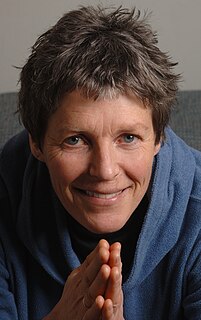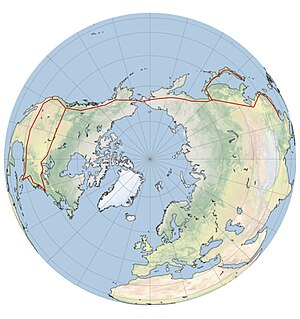
The North Pole, also known as the Geographic North Pole or Terrestrial North Pole, is the point in the Northern Hemisphere where the Earth's axis of rotation meets its surface. It is called the True North Pole to distinguish from the Magnetic North Pole.

Sir David Kim Hempleman-Adams, is a British industrialist and adventurer.
Ralph Summers Plaisted and his three companions, Walt Pederson, Gerry Pitzl and Jean-Luc Bombardier, are regarded by most polar authorities to be the first to succeed in a surface traverse across the ice to the North Pole on 19 April 1968, making the first confirmed surface conquest of the Pole.
Rune Gjeldnes is a Norwegian adventurer. He completed his military education in 1992, when he met fellow adventurer-to-be Torry Larsen, also of Møre og Romsdal. Gjeldnes served in the Norwegian Naval Special Operations Command until 1997.
Will Steger is a prominent spokesperson for the understanding and preservation of the Arctic and has led some of the most significant feats in the field of dogsled expeditions; such as the first confirmed dogsled journey to the North Pole in 1986, the 1,600-mile south–north traverse of Greenland - the longest unsupported dogsled expedition in history at that time in 1988, the historic 3,471-mile International Trans-Antarctic Expedition - the first dogsled traverse of Antarctica (1989–90), and the International Arctic Project - the first and only dogsled traverse of the Arctic Ocean from Russia to Ellesmere Island in Canada during 1995.

Børge Ousland is a Norwegian polar explorer, photographer and writer. He was the first person to cross Antarctica solo.
Paul Landry M.B. is a French-Canadian polar explorer, author, and adventurer who is the only paid man to ever reach three Geographical poles in a single year.

Liv Ragnheim Arnesen is a Norwegian educator, cross-country skier, adventurer, guide, and motivational speaker. Arnesen led the first unsupported women’s crossing of the Greenland Ice Cap in 1992. In 1994, she made international headlines becoming the first woman in the world to ski solo and unsupported to the South pole. – a 50-day expedition of 745 miles (1,200 km).
Josée Auclair is a Canadian explorer.
Matty L McNair is an American explorer. She now lives in the Canadian Arctic in Iqaluit, Nunavut, on Baffin Island, where she runs her company NorthWinds. Among her many accomplishments are:

The South Pole, also known as the Geographic South Pole or Terrestrial South Pole, is one of the two points where Earth's axis of rotation intersects its surface. It is the southernmost point on the surface of Earth and lies on the opposite side of Earth from the North Pole.

Arctic exploration is the physical exploration of the Arctic region of the Earth. It refers to the historical period during which mankind has explored the region north of the Arctic Circle. Historical records suggest that humankind have explored the northern extremes since 325 BC, when the ancient Greek sailor Pytheas reached a frozen sea while attempting to find a source of the metal tin. Dangerous oceans and poor weather conditions often fetter explorers attempting to reach polar regions and journeying through these perils by sight, boat, and foot has proven difficult.

Felicity Ann Dawn Aston is an English explorer and former climate scientist.
Eric Larsen is an American Polar adventurer known for his expeditions to the North Pole, South Pole, and Mount Everest.
John Huston is an American polar explorer, motivational speaker, wilderness guide, and safety and logistics consultant. In 2009, Huston completed the first successful unsupported American expedition to the North Pole. He has also completed expeditions to the South Pole, Greenland, and Ellesmere Island. Huston is the co-author of Forward: The First American Unsupported Expedition to the North Pole.
Jade Hameister is an Australian woman who, at age 16, became the youngest person in history to pull off the "polar hat-trick", ski to the North and South Poles, and cross the second largest polar icecap on the planet: Greenland. Hameister travelled over 1,300 km on these three missions, which totalled almost four months on ice.

The book North to the Pole written by Will Steger and Paul Schurke was published in 1986. It is a first-person account of an expedition to the North Pole and illustrates how seven men and one woman set out by dog-sled to accomplish the goal of completing the first “unsupported” expedition to the North Pole. “Unsupported” in that case means without resupply and only with the help of traditional navigation systems. The expedition is successfully completed within 56 days, and the crew is much praised and celebrated for it, especially by the media.







